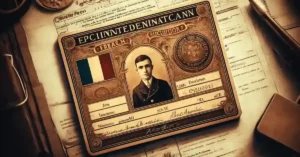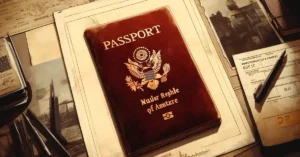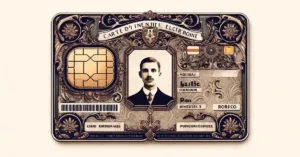Verifying a person’s identity is necessary across numerous sectors to prevent fraud and identity theft.
Passports are documents widely used for this purpose and include several security features. So, how can you verify a German passport online and ensure the presented document is authentic? Find the answer in this article!
Need more information on how to verify the authenticity of your ID documents ? Check out our comprehensive guide to verifying ID documents, which includes all the resources available !
Check 1: General Appearance for Verifying a German Passport Online
The first step to verify a German passport online, when you have access to the original document, is to examine the overall appearance: there should be no signs of cutting, peeling, modification, or rectification.
Pay particular attention to the area at and around the photo.
Check 2: Read, Cross-Check, and Verify Numbers and Information on German Passports
The second step to verify a German passport online is to ensure the consistency of the information on the document.
Document Type
The document type can be found at the top left and at the beginning of the first line of the MRZ (Machine Readable Zone).
![Verify a German passport, document type (Ref. [1]) Verify a German passport, document type (Ref. [1])](https://trustdochub.com/wp-content/uploads/2025/05/Verifier-un-passeport-allemand-type-de-document.webp)
German Passport Document Number
The document number can be found in two places: at the top right and at the beginning of the second line of the MRZ.
Both must be identical:
![Verify a German passport, document number (Ref. [1]) Verify a German passport, document number (Ref. [1])](https://trustdochub.com/wp-content/uploads/2025/05/Verifier-un-passeport-allemand-numero-de-document.webp)
Date of Birth
The holder’s date of birth can also be found in two distinct places: in the center right and in the middle of the second MRZ line in YYMMDD format:
![Verify a German passport, date of birth (Ref. [1]) Verify a German passport, date of birth (Ref. [1])](https://trustdochub.com/wp-content/uploads/2025/05/Verifier-un-passeport-allemand-date-de-naissance.webp)
Surname and Given Name(s)
Similarly, the surname and given name(s) can be found on the document and in the first line of the MRZ:
![Verify a German passport, surname (Ref. [1]) Verify a German passport, surname (Ref. [1])](https://trustdochub.com/wp-content/uploads/2025/05/Verifier-un-passeport-allemand-nom.webp)
Holder’s Gender
The holder’s gender is indicated by “M” for male and “F” for female. This information is found on the front and in the second line of the MRZ:
![Verify a German passport, holder's gender (Ref. [1]) Verify a German passport, holder's gender (Ref. [1])](https://trustdochub.com/wp-content/uploads/2025/05/Verifier-un-passeport-allemand-genre-du-titulaire.webp)
Document Expiry Date
Another element present twice on the document is the expiry date, found on the front and in the second MRZ line in YYMMDD format:
![Verify a German passport, expiry date (Ref. [1]) Verify a German passport, expiry date (Ref. [1])](https://trustdochub.com/wp-content/uploads/2025/05/Verifier-un-passeport-allemand-date-dexpiration.webp)
Issuing Country
The issuing country can be found in two places on the document: at the top of the front page and at the beginning of the first MRZ line.
Nationality
The holder’s nationality can be found in the second MRZ line in ISO 3166-1 format:
![Verify a German passport, nationality (Ref. [1]) Verify a German passport, nationality (Ref. [1])](https://trustdochub.com/wp-content/uploads/2025/05/Verifier-un-passeport-allemand-nationalite.webp)
Check 3: Verify a German Passport with its MRZ Strip
The bottom part of the German passport consists of two lines that replicate the information on the document, with validation keys to prevent reading errors or forgeries.
Structure of the German Passport MRZ Strip
First Line

- Document Type: 2 characters, code indicating the document type, represented by the letters “P<”.
- Issuing Country: 3 characters, the ISO 3166-1 alpha-3 code of the issuing country.
- Surname(s): holder’s surname(s), separated by a “<” chevron.
- Given Name(s): holder’s given name(s), separated from the surname by two chevrons and separated from each other by a “<” chevron.
Second Line

- Document Number: 9 characters, the passport number printed on the document.
- Check Digit: 1 character, check digit for the document number.
- Nationality: 3 characters, holder’s nationality.
- Date of Birth: 6 digits, holder’s birth date in YYMMDD format.
- Check Digit: 1 character, check digit for the date of birth.
- Sex: 1 character, holder’s gender (“M” or “F”).
- Expiry Date: 6 digits, passport expiry date in YYMMDD format.
- Personal Number: 11 characters, holder’s personal number.
- Check Digit: 1 character, check digit for the personal number.
- Check Digit: 1 character, check digit for the concatenation of characters from line 2 positions 44-54, 57-64, and 65-87.
Verify a German Passport with the MRZ Security Keys
A German passport contains 5 check digits (or security keys) that validate the preceding information.
These prevent transcription errors or intentional/unintentional modifications.
How Does the Algorithm Work?
The algorithm used to create and validate check digits is common to all identity documents: characters have a weight, which is multiplied by a factor depending on their position in the string (7, 3, and 1).
Digits have their numeric value (“0” = 0, “1” = 1, … “9” = 9), the chevron “<” also has a value of 0, while letters start at 10 for “A”, 11 for “B”, up to 35 for “Z”.
Example
Let’s take as an example the check digit for the date of birth of the specimen above.
The character string to validate is: “830812”.
To calculate the check digit, proceed as follows:
– “8” has a value of 8 and is in the first position, multiply by 7: 8 * 7 = 56
– “3” has a value of 3 and is in the second position, multiply by 3: 3 * 3 = 9, added to previous 56, total 9 + 56 = 65.
– “0” has a value of 0 and is in the third position, multiply by 1: 0 * 1 = 0, added to previous 65, total 0 + 65 = 65.
– “8” * 7 = 56 and 56 + 65 = 121
– “1” * 3 = 3 and 3 + 121 = 124
– “2” * 1 = 2 and 2 + 124 = 126
The total is 126, from which we take modulo 10 (the remainder of division by 10), which corresponds to the last digit: “6”.
Our check digit is therefore valid because the document shows a 6!
Individuals, do you occasionally need to verify one or more identity documents ?
Professionals, do you need to integrate proof of identity validation into one of your business processes, including all European identity cards and global passports ?
Check 4: Security Features to Verify the Authenticity of a German Passport
An identity document has various elements that help validate its authenticity.
This is the final step to verify a German passport online, and the longest one: we will review the different security features present on the pages of the German passport.
Title Page
Personalized Security Thread (1)
A machine-verifiable security thread is integrated into the title page and personalized with the document number and the holder’s surname(s) and given name(s).
Security Fibers (2)
The title page contains invisible security fibers that fluoresce under UV light. The security paper also contains fibers, some of which are luminescent.
Surface Embossing (3)
The federal eagle, part of the musical notation of the national anthem, and the letter “D” are embossed in relief, both positive and negative, on the surface of the card.
Variable Laser Image (4)
When the card is tilted, the image or the holder’s date of birth becomes visible depending on the viewing angle.
Data Page
Personalization (5)
The photo and the document number are integrated into the data page using inkjet technology. Other personal data are laser engraved on the title and data pages.
UV Features (6)
Patterns printed using the Rainbow (split-duct) process are visible under UV lighting, and part of the visible security pattern is luminescent.
Kinegram Structures (7)
The green elements visible above the passport holder’s photo change and move when the data page is tilted. The federal eagle turns red when rotated 180 degrees.
Holographic Portrait and Blue Stripe (8)
The holder’s image appears to the right of the photo as a green hologram. When rotated 90°, the personal data and other design elements appear in blue.
Visa Page
Machine-readable Zone (9)
The MRZ content also appears as a hologram: the passport serial number and the holder’s surname are displayed in green, while other characters appear in blue.
Tactile Features (10)
The issue and expiry dates as well as the holder’s nationality are laser engraved with tactile letters.
Security Printing (11)
Security printing consists of complex patterns, multicolor guilloches, and an anti-copy pattern. It is produced using the rainbow printing process.
Microprinting (12)
Positive and negative microprinting elements of various sizes are integrated into the design of the security printing.
Window (13)
The window appears blue on a light background and red on a dark background. When lit, the window appears red and the projection appears blue on a light background.
Optically Variable Ink (14)
When the data page is tilted, the letter “D” changes color between green and blue depending on the viewing angle and lighting.
Security Paper (15)
The security paper shows watermarks with varied patterns. A security thread is also integrated into the security paper.
Laser-perforated Serial Number (16)
The paper pages and back cover are laser-perforated with the serial number.
Conclusion
You now have all the keys to verify a German passport online and ensure it is authentic!
No specialized equipment is needed: with a bit of vigilance and time, you can avoid most of the frauds encountered daily!
You can also use our service, which performs the checks in seconds via our web app: results are available directly in the application and as a PDF report!
Individuals, do you occasionally need to verify one or more identity documents ?
Professionals, do you need to integrate proof of identity validation into one of your business processes, including all European identity cards and global passports ?
References
[1]: Image from the Federal Ministry of the Interior — Public domain — Source: Wikimedia Commons
[2]: Images from the Federal Ministry of the Interior — Public domain

![Verify a German passport, issuing country (Ref. [1]) Verify a German passport, issuing country (Ref. [1])](https://trustdochub.com/wp-content/uploads/2025/05/Verifier-un-passeport-allemand-pays-emetteur.webp)
![Verify a German passport, title page (Ref. [2]) Verify a German passport, title page (Ref. [2])](https://trustdochub.com/wp-content/uploads/2025/05/Verifier-un-passeport-allemand-page-de-titre.webp)
![Verify a German passport, personalized security thread (Ref. [2]) Verify a German passport, personalized security thread (Ref. [2])](https://trustdochub.com/wp-content/uploads/2025/05/Verifier-la-validite-dun-passeport-allemand-Fil-de-securite-personnalise.png)
![Verify a German passport, security fibers (Ref. [2]) Verify a German passport, security fibers (Ref. [2])](https://trustdochub.com/wp-content/uploads/2025/05/Verifier-la-validite-dun-passeport-allemand-fibres-de-securite.png)
![Verify a German passport, surface embossing (Ref. [2]) Verify a German passport, surface embossing (Ref. [2])](https://trustdochub.com/wp-content/uploads/2025/05/Verifier-la-validite-dun-passeport-allemand-gaufrage-superficiel.png)
![Verify a German passport, variable laser image (Ref. [2]) Verify a German passport, variable laser image (Ref. [2])](https://trustdochub.com/wp-content/uploads/2025/05/Verifier-la-validite-dun-passeport-allemand-image-laser-variable.png)
![Verify a German passport, data page (Ref. [2]) Verify a German passport, data page (Ref. [2])](https://trustdochub.com/wp-content/uploads/2025/05/Verifier-un-passeport-allemand-page-donnees.webp)
![Verify a German passport, personalization (Ref. [2]) Verify a German passport, personalization (Ref. [2])](https://trustdochub.com/wp-content/uploads/2025/05/Verifier-un-passeport-allemand-personnalistion.png)
![Verify a German passport, UV (Ref. [2]) Verify a German passport, UV (Ref. [2])](https://trustdochub.com/wp-content/uploads/2025/05/Verifier-un-passeport-allemand-UV.png)
![Verify a German passport, kinegram structures (Ref. [2]) Verify a German passport, kinegram structures (Ref. [2])](https://trustdochub.com/wp-content/uploads/2025/05/Verifier-un-passeport-allemand-structures-cinematiques.png)
![Verify a German passport, holographic portrait (Ref. [2]) Verify a German passport, holographic portrait (Ref. [2])](https://trustdochub.com/wp-content/uploads/2025/05/Verifier-un-passeport-allemand-portrait-holographique.png)
![Verify a German passport, visa page (Ref. [2]) Verify a German passport, visa page (Ref. [2])](https://trustdochub.com/wp-content/uploads/2025/05/Verifier-la-validite-dun-passeport-allemand-page-visa.webp)
![Verify a German passport, mrz (Ref. [2]) Verify a German passport, mrz (Ref. [2])](https://trustdochub.com/wp-content/uploads/2025/05/Verifier-un-passeport-allemand-mrz.png)
![Verify a German passport, tactile features (Ref. [2]) Verify a German passport, tactile features (Ref. [2])](https://trustdochub.com/wp-content/uploads/2025/05/Verifier-un-passeport-allemand-fonctionnalites-tactiles.png)
![Verify a German passport, security printing (Ref. [2]) Verify a German passport, security printing (Ref. [2])](https://trustdochub.com/wp-content/uploads/2025/05/Verifier-un-passeport-allemand-impression-de-securite.png)
![Verify a German passport, microprinting (Ref. [2]) Verify a German passport, microprinting (Ref. [2])](https://trustdochub.com/wp-content/uploads/2025/05/Verifier-un-passeport-allemand-micro-impression.png)
![Verify a German passport, window (Ref. [2]) Verify a German passport, window (Ref. [2])](https://trustdochub.com/wp-content/uploads/2025/05/Verifier-la-validite-dun-passeport-allemand-fenetre.png)
![Verify a German passport, optically variable ink (Ref. [2]) Verify a German passport, optically variable ink (Ref. [2])](https://trustdochub.com/wp-content/uploads/2025/05/Verifier-la-validite-dun-passeport-allemand-encre-optiquement-variable.png)
![Verify a German passport, security paper (Ref. [2]) Verify a German passport, security paper (Ref. [2])](https://trustdochub.com/wp-content/uploads/2025/05/Verifier-la-validite-dun-passeport-allemand-papier-de-securite.png)
![Verify a German passport, laser-perforated serial number (Ref. [2]) Verify a German passport, laser-perforated serial number (Ref. [2])](https://trustdochub.com/wp-content/uploads/2025/05/Verifier-la-validite-dun-passeport-allemand-numero-de-serie-perfore.png)


